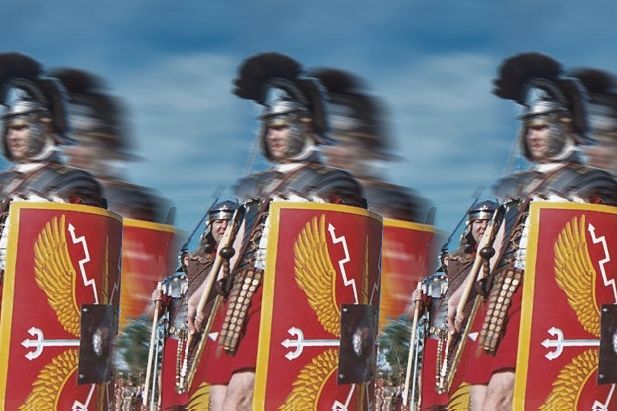


| |
The Romans in The Netherlands   
It was wonderful and exciting news when in the year 54 B.c. swift runners brought word that the south men, the Romans, were marching by the thousands toward the Rhine. From their lookouts in the treetops, these stalwart men of the north saw the flashing brass helmets of the Roman soldiers. At first they were afraid of them. They saw that these warriors from sunny lands wore tunics, or short coats, with greaves on their lower limbs, but not leggings or trousers, like the men of colder climes. At night they wrapped themselves in cloaks. They carried short, iron swords, and shields made strong with hide and metal. On their bodies they had armor, their shoulders being especially well guarded with bands and plates of bronze.
These southern men were not, as a rule, so tall as those in the north. Indeed, many of them seemed to the Germans to be mere boys. So the tribesmen plucked up courage, gathered themselves together, and went out with their spears and swords, expecting to drive the Romans away and kill them all, but they had made a great mistake. The Romans were not only brave, but they were cool and obeyed orders. They stood together close in ranks and could not be driven back, even when the heavier tribesmen rushed at them in great crowds. It was the Roman discipline that conquered. These "boys" kept their ground, first receiving the blows of the barbarians upon their shields, and then thrusting the enemy through with their short swords.
There was no steel in those days, and if a soldier bent his sword, he put it under his foot and straightened it out again. In the end, Caesar, who had eight legions, or about 50,000 men, conquered the Netherlands south of the Rhine. Other generals followed Caesar, and soon the golden eagles and banner of Rome were seen all over the land. The Batavians, or the men who lived on the island of Betuwe famous for its pastures and the regions around, were such good fighters on horseback that they were invited, 13 B.c., to enter the Roman army.
This they did, becoming the life or body guard of the Roman emperor. They served as Batavian cavalry in many campaigns, even in far-off southern Europe and in Greece, once deciding a great battle by their valor. The history of the Netherlands becomes brighter after the Romans entered the country, for these southerners understood writing, and letters bring light. Caesar has told his story in Latin, which, though it seems to the schoolgirls and schoolboys beginning it hard to translate, is very clear. Yet Caesar wrote only about the earliest wars. We wish some other Romans, during the following centuries, had written equally well about later events and their own lives and work; for very many people came up from Italy and the southern countries, and thousands of them lived in the Netherlands during 500 years.
They built roads, canals, and forts, laid out farms, and reared houses and temples. They made a very large walled camp on the seashore near Leyden, which they called the House towards Britain. One general, named Drusus, 11 B.c., had a long canal cut, which joined the waters of the Rhine and the IJssel rivers, so that they flowed to Lake Flevo, where is now the IJsselmeer, and out to the German Ocean through the Vlie. After that, a Roman galley could be rowed from inland Germany to the British Isles, or enter from the North Sea into the heart of Europe.
We know fairly well what cities there were in the times of the empire and where the garrisons were placed. While the Romans had their farms, the natives kept their marks, or divisions of land, and thus the one set of men learned a great deal from the other. A mark was a tract of land owned by a tribe or family in common. All the people could cut wood from the forest for their fires or to make houses or tools, and all were allowed to keep their pigs in the woods, or to let their cows graze upon the meadows, for the land of the community was free to all.
On the other hand, the Romans measured and divided their land into farms, each owned by one person. In later ages some of the Roman laws and customs were adopted by these Germanic tribes that became Dutch and English, so that not a few Latin words, now spelled "farm," "canal," "street," "port," or "common," have remained in our language. Even the "common," or " green," which we see in our towns and villages, is a relic of these old days. In time the Romans became Christians, and thus, through them, one of the greatest blessings brought into this northern land was the religion of Jesus, which softened manners and kindled in men's hearts the greatest of all hopes.
Let us look at some of the Roman cities in the far north. Beginning at the south, there was Noviomagum, which is now called Nijmegen. We must remember that these Latin names, sooner or later, became changed into Dutch, and that the names we now see on the map have grown out of the Latin; as, for example, Vianen, from Fanum Dianae, or Diana's Shrine. In some cases the Latin name, like Lugdunum, now perhaps the city of Leyden, was only the southern man's way of pronouncing Lugdun, the name already there, which has in it "lug," now our word "look."
| |
|















